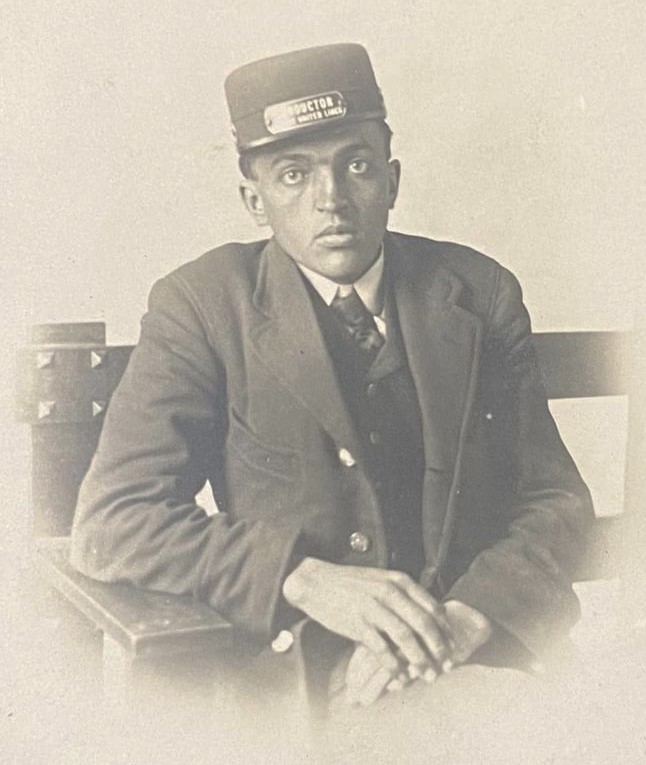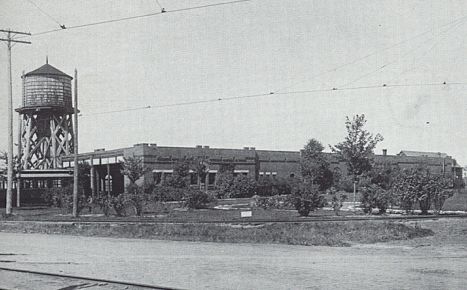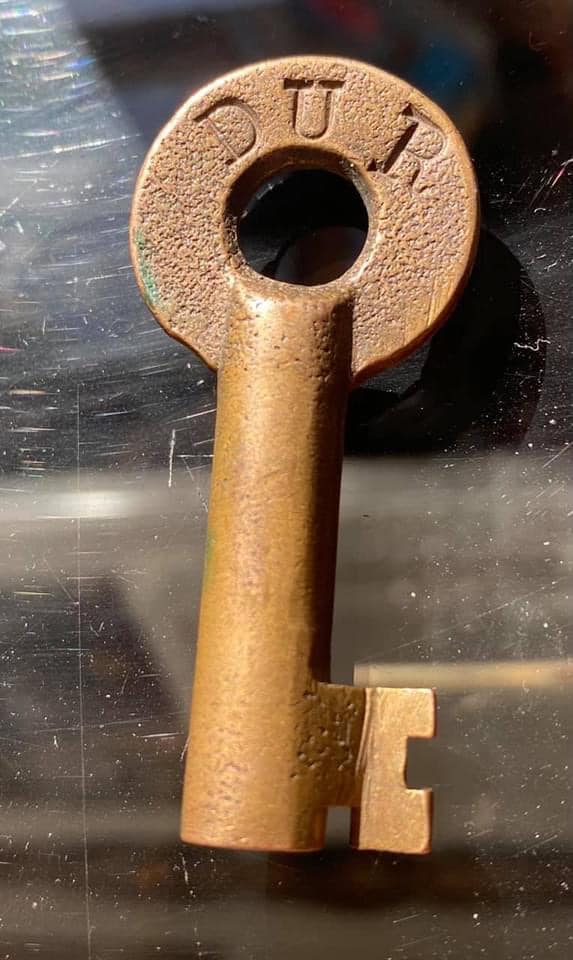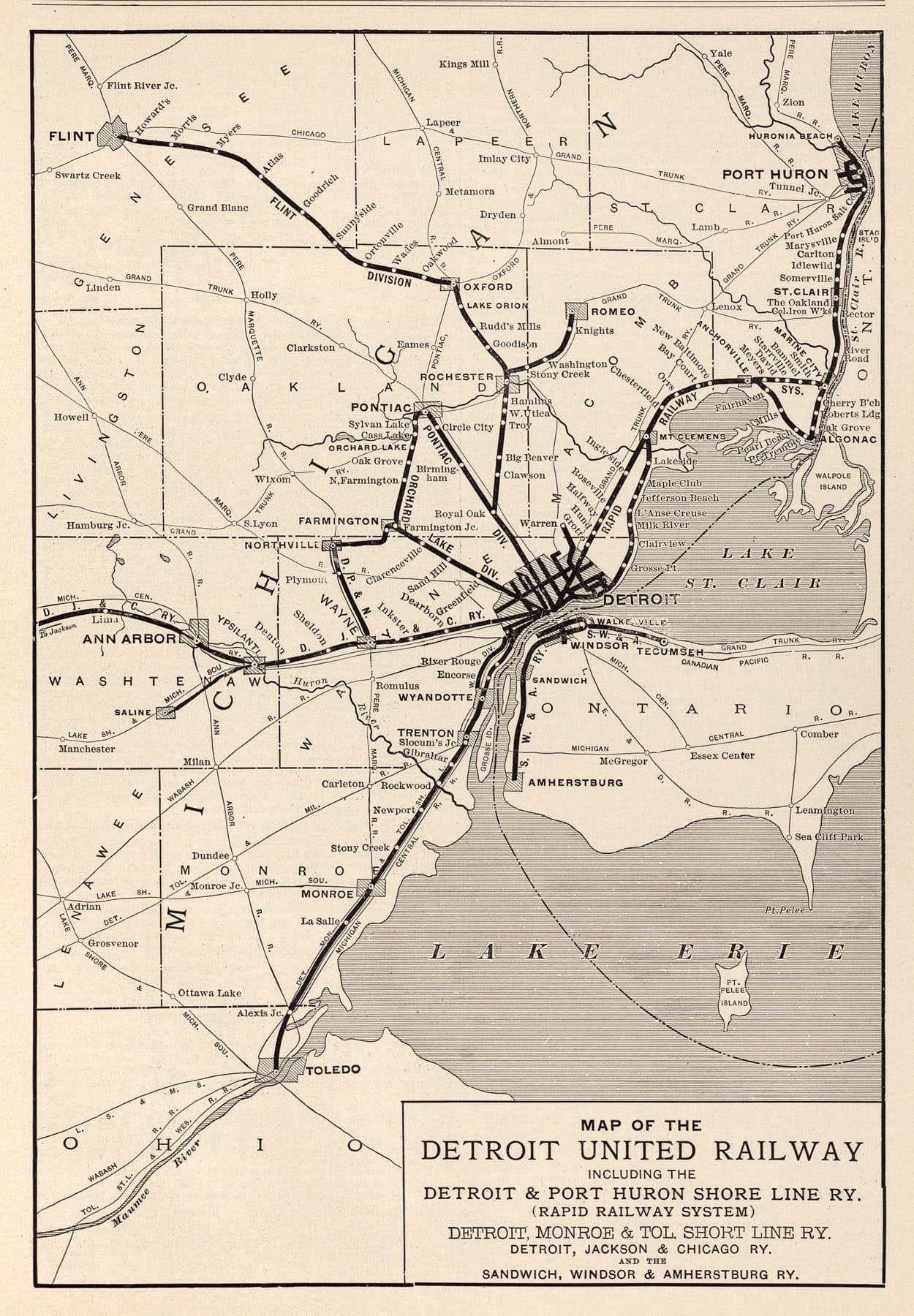- Details
- Hits: 4710
Railroad: Detroit United Railway Company
 The Detroit United Railway was operated from 1901 until 1934. The DUR acquired for than a dozen interurban and street railway companies reaching from Detroit as Flint, Jackson Port Huron and Toledo, and operated them as a system. As early as 1922, the company began selling portions of their operation to the City of Detroit Department of Street Railways (DSR), as well as to the City of Royal Oak and Pontiac. The remainder were abandoned between 1925 and 1934. [MRL]
The Detroit United Railway was operated from 1901 until 1934. The DUR acquired for than a dozen interurban and street railway companies reaching from Detroit as Flint, Jackson Port Huron and Toledo, and operated them as a system. As early as 1922, the company began selling portions of their operation to the City of Detroit Department of Street Railways (DSR), as well as to the City of Royal Oak and Pontiac. The remainder were abandoned between 1925 and 1934. [MRL]
Image info: A DUR conductor poses for a photo in the early 1900's.
Various → Detroit United Railway → Cities of Detroit, Royal Oak and Pontiac
Consolidated lines: In 1901 (see list)
Operated for 27 years.
Became: Eastern Michigan Railways in 1928.
Reference: [MRRC]
 Photo Info: This is an early photo of the DUR car barn in Farmington, Michigan. [ALC] The map at the bottom of the page shows the DUR lines in Michigan.
Photo Info: This is an early photo of the DUR car barn in Farmington, Michigan. [ALC] The map at the bottom of the page shows the DUR lines in Michigan.
Notes
This was an electric line. The following lines were consolidated into the Detroit United [MRRC]:
- Detroit Citizens Street Railway - 1900
- Detroit, Fort Wayne & Belle Isle - 1900
- Detroit Suburban - 1900
- Detroit Electric - 1900
- Wyandotte & Detroit River - 1901
- Detroit & Northwestern - 1901
- Detroit & Pontiac Ry. - 1901
- Detroit & Port Huron Shore Line - 1901
- Detroit & Flint - 1901
- Detroit, Monroe & Toledo Short Line - 1906
- Detroit, Almont & Northern - 1913
- Highland Park & Royal Oak - 1916
Time Line
1902: DUR lines are powered by the following generating stations:
- Stations A and B - powers downtown Detroit, and south to Trenton.
- Station D - Farmington Junction (DC) - powers from Detroit limits to Farmington and from there north to Pontiac
- Station E - Birmingham (DC) - powers from Royal Oak to Pontiac
- Station F - (DC) Pontiac -
- Station G - Rochester (AD/DC) - powers Big Beaver to Rochester, Ortonville and Romeo.
- Atlas Substation - Atlas (near Goodrich) - powers Ortonville north to Flint
- Oxford Booster - (from Station G) - powers Lake Orion to Ortonville
- Ecorse Storage Battery - powers from southwest Detroit to Trenton
1902. SNAPSHOT of the Flint Division. From Royal Oak to Flint and to Romeo, the road is constructed with 67-lb. steel rail and oak ties in good condition. Passenger stations are small but seem to meet the requirements of the public. Half interlockers are in good repair. There is a good deal of freight business done on this line. From Lake Orio to Romeo the road is quite crooked, but all curves have the proper elevation and the majority of them have guard rails. From Lake Orion to Flint the road is mostly on private right of way and is generally fenced. All passenger cars are equipped with the straight air brake, with storage tank for air. Electric headlight, smoking room, closet, water tank, signal lights, frags and gongs. Heated with Smith hot water heater; no fire protection; no tools to use in case of emergency. No signal whistle or whistling posts. Road has the necessary side tracks which are equipped with split point switches and spring rail frogs. Highway crossing planks are in good condition. [MCR-1903]
1902. SNAPSHOT of the Pontiac Division. From Detroit to Pontiac is a double track main line with the exception of one mile, and is in first-class condition. Constructed with 67-lb. steel rail. Two half-interlockers at Pontiac have been rebuilt with a year and are in good condition. The power house is located at Birmingham. Passenger and express equipment comprises 12 passenger cars and one express car. Cars have double trucks, weigh about 30 tones, and have four 75-horsepower motors, Westinghouse equipment with straight air brake; headed with Smith hot water heater; electric head light, cars provided with signal lamps and flags; no signal whistle or whistling posts; no fire protection or tools for use in case of emergency. Wire construction is in good condition. The line is divided into three sections with four section men to a section. This is a trolley system. Motormen must test the air brakes 2,000 feet from all steam railroad crossings and junction points. Company rules require all cars to reducer speed when passing on double track or sidings. Telephones are used for train orders and are located at passing sidings. There is a dispatcher; the one on duty is the only person authorized to move cars on the main line. When necessary to stop at a telephone for orders, the car must be stopped with the vestibule directly opposite the phone. The conductor receives the order from the dispatcher which must be repeated back in sufficiently loud tone to permit the motorman hearing; if the order is correctly understood the dispatcher will reply "Correct". [MCR-1903]
1915: Fifteen passengers in a DUR train were killed in a collision with a DT&I train at Delray. See article link below.
 1916. December 16. The Detroit United Railway Sells to Pennsylvania. Steam railroad buys land at West Congress and sixth streets.
1916. December 16. The Detroit United Railway Sells to Pennsylvania. Steam railroad buys land at West Congress and sixth streets.
Through its publicity agent, D. B. Van Zant, announcement was made last night by the Detroit United lines that its freight depot at the foot of Sixth Street had been sold to the Pennsylvania Railroad.
The rumor in existence for several weeks that the Pennsylvania was negotiating with the DUR was confirmed after the traction company had fully completed its negotiations for a new freight terminal between St. Aubin and Chene and Monroe and Macomb adjacent and in connection with its car repair shops which are being abandoned with the enlargement of the Highland Park shops.
In removing its freight terminal from the west side of Woodward Avenue to the east, the street railway company believes it is going to have a more central location. The area for freight purposes is greatly enlarged by the shift from one side of the city to the other because in the move, the company will have 2 1/2 blocks in which to carry out its growing business. [DFP-1916-1216]
Photo info: The DUR switch key, from the Northeast Oakland History Museum.
1920. The Detroit United Railway electric lines have five sets of team tracks which hold 178 cars and 3 freight houses. [DWT-1920]
Books and Articles:
Maps

Bibliography
The following sources are utilized in this website. [SOURCE-YEAR-MMDD-PG]:
- [AAB| = All Aboard!, by Willis Dunbar, Eerdmans Publishing, Grand Rapids ©1969.
- [AAN] = Alpena Argus newspaper.
- [AARQJ] = American Association of Railroads Quiz Jr. pamphlet. © 1956
- [AATHA] = Ann Arbor Railroad Technical and Historical Association newsletter "The Double A"
- [AB] = Information provided at Michigan History Conference from Andrew Bailey, Port Huron, MI

